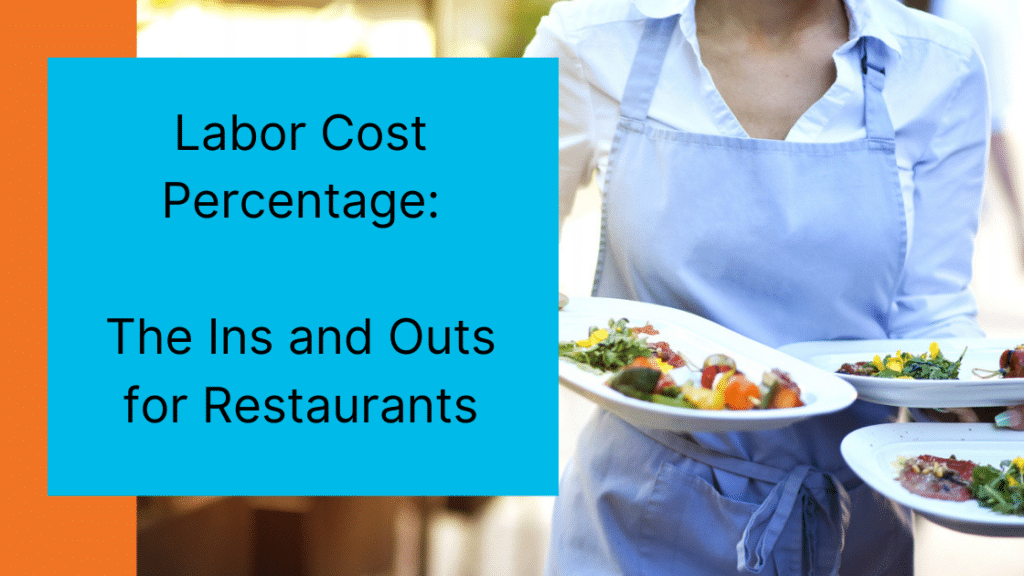Running a successful restaurant goes beyond crafting delectable dishes and providing excellent service; it involves strategic financial management, with labor costs being a crucial aspect, that includes the intricacies of labor cost percentage. We’ll help you understand what the labor cost percentage is, how to calculate it, and how to utilize the data to enhance your restaurant’s overall efficiency and profitability.
What is Labor Cost Percentage?
Restaurant labor cost percentage is a bit different than just plain old restaurant labor cost. It figures labor costs as they relate to overall sales or operating expenses. In short, it is a more helpful metric than just a simple labor cost number. For instance, if your labor costs are very low, but your profits are also very low, that’s not ideal. This would be reflected in a labor cost percentage number that is higher.
When you’re looking for a good labor cost percentage, lower is better. If for example your labor cost percentage is 50%, things probably aren’t going too well financially. Track labor costs as a percentage of revenue. Efficient staff scheduling and management can help optimize this metric.
Labor cost percentage is a key performance indicator that measures the proportion of a restaurant’s revenue spent on labor expenses. It provides insights into the efficiency of staffing levels and the impact on the overall financial health of the establishment.
How to Calculate Labor Cost Percentage
Calculating restaurant labor cost percentage is pretty simple. Just take the total cost of labor over a desired period and divide it by the total sales from that same period. You can determine labor cost percentage per day, week, month, or even year with a simple formula. The formula for calculating labor cost percentage is straightforward:
Labor cost percentage = (Total Revenue / Total Labor Costs) × 100
This calculation takes into account all labor-related expenses, including wages, benefits, and taxes, and expresses them as a percentage of total revenue. Here’s another example with real numbers:
If your restaurant paid employees $4,000 in a week and brought in $10,000 in revenue, a labor cost percentage calculation would be as follows:
4,000/10,000=.4 x 100 = 40%
If your restaurant business has many streams of income that comprise revenue, it may also be useful to use the same formula to calculate the labor cost percentage of just one of those revenue sources, like food sales. In that way, you can see how profitable your main business is, without skewing the percentage because of other revenue streams that don’t require as much labor, such as rental or investment revenue.
What to Look for in Labor Cost Percentage Data
From analyzing trends and benchmarking against industry standards to assessing staffing efficiency and managing overtime costs, understanding what to look for in labor cost percentage data is pivotal for restaurants striving to strike the delicate balance between exceptional service and financial prudence. Here are more examples of what to look for in labor cost percentage data.
Labor Cost Percentage Trends
An important aspect to understanding your labor cost percentage data is tracking trends over time. A meticulous analysis of these trends unveils patterns that can be crucial for strategic decision-making.
Analyze labor cost trends over different time periods (daily, weekly, monthly). Are there consistent increases in labor cost percentage, indicating potential inefficiencies or staffing challenges? Or do you observe a declining trend, suggesting improved operational efficiency? Consistently high or increasing labor costs may indicate issues.
Understanding the trajectory of these percentages helps in making informed decisions about staffing levels, scheduling, and overall labor management.
Comparison to Industry Benchmarks
Comparing your labor cost percentage to industry benchmarks provides valuable insight for performance evaluation. If your restaurant’s labor cost percentage surpasses industry standards, it may be a signal to investigate potential inefficiencies in staffing or explore cost-cutting measures.
Conversely, falling below benchmarks might raise concerns about service quality due to understaffing. Benchmarking allows for a contextual understanding of your restaurant’s labor performance in the broader industry landscape.
Compare your labor cost percentage to industry benchmarks to assess how efficiently your restaurant manages labor expenses relative to competitors.
Staffing Efficiency
Optimal staffing is at the heart of managing labor cost percentage effectively. Periodically evaluating staffing levels during different shifts and adjusting schedules based on customer demand ensures a fine balance between providing quality service and controlling costs.
Consider cross-training programs to maximize staff versatility, ensuring that your workforce is agile and capable of handling various roles during peak times. Evaluate staff scheduling and labor efficiency by comparing labor costs to customer traffic. Determine if staffing levels are appropriate for various shifts and days.
Overtime and Extra Labor Costs
The management of overtime and additional labor costs is another critical facet of interpreting labor cost percentage data. Excessive overtime can significantly inflate labor expenses, impacting profitability. Restaurant staffing optimization is a key element in keeping your restaurant labor cost in an acceptable range, but it’s also a difficult metric to track and accurately represent.
Having a back-office system tracking each staffer’s time on the clock, unnecessary overtime can be reduced and even eliminated with automated alerts. Properly programmed, a back-office system will send managers and owners real-time alerts with a text message or push notification, signaling specific employees are approaching overtime, greatly simplifying the decision to keep or cut staff.
Also look for patterns in overtime usage, assess whether it aligns with peak times or is indicative of understaffing during regular shifts, and explore strategies to optimize scheduling and reduce unnecessary labor costs. Monitor overtime expenses and the use of additional labor resources during peak times or special events.
Common Labor Cost Percentage Problems and Solutions
Labor cost percentage reflects the financial health of an establishment and also unveils the efficacy of staffing strategies and their impact on overall operational efficiency. However, as with any intricate choreography, challenges emerge.
Here we will address some common problems that restaurants encounter in managing labor cost percentage and some helpful solutions to help with high labor cost percentages, rising costs, and more.
Consistently High Labor Cost Percentage
A consistently high labor cost percentage may indicate overstaffing, inadequate sales, or inefficient labor management. To help correct this you should analyze staffing levels during different shifts, adjust schedules based on peak times, and cross-train staff for versatility. Consider implementing these solutions to optimize scheduling and reduce unnecessary labor costs.
Staff Scheduling
Review and optimize staff scheduling to ensure that labor resources are allocated efficiently, particularly during peak and slow hours. High labor cost percentages often result from overstaffing during slower periods or understaffing during peak hours, leading to an imbalance that strains operational efficiency. Guests who wait too long for service have a bad experience and don’t return, and having too many employees on hand for sales demand swells labor costs.
The strategic solution lies in mastering the art of staff scheduling—leveraging historical data to predict peak times, implementing technology solutions to optimize shifts, and adopting flexible scheduling models that adapt to the dynamic nature of the restaurant business. Having a back-office system equipped with a predictive scheduling feature can almost eliminate staffing guesswork. These systems can tap into historical sales data from the POS and suggest staff scheduling based on forecasted sales.
Cross-Training
High labor cost percentages often signal inefficiencies within a restaurant’s operational framework, and cross-training emerges as a strategic solution to address this challenge. When staff members are specialized in specific roles, fluctuations in demand can lead to either overstaffing or understaffing, contributing to an imbalance in labor costs.
Cross-training employees to handle various roles within the establishment promotes versatility and adaptability. This approach not only fosters a more agile workforce but also ensures that staffing levels can be adjusted dynamically based on demand. The strategic implementation of cross-training becomes a cornerstone solution for high labor cost percentages, allowing restaurants to optimize labor efficiency, mitigate costs, and elevate operational resilience in the face of fluctuating demands.
Labor Analytics
The strategic implementation of labor analytics emerges as a powerful solution to the challenge of high labor cost percentages. Labor analytics offers a nuanced understanding of staffing needs, peak hours, and operational patterns.
Use data analytics tools to forecast customer traffic accurately and adjust staffing levels accordingly. By harnessing data-driven insights, restaurateurs can optimize staff scheduling, identify peak times, and align workforce resources with customer demand. This strategic use of labor analytics not only aids in the mitigation of high labor costs but also fosters a proactive approach to managing labor efficiency.
With the complexities of high labor cost percentages, the integration of labor analytics stands as a transformative solution, empowering restaurants to make informed decisions, enhance operational effectiveness, and achieve a harmonious balance between workforce optimization and financial prudence.
Rising Labor Costs Over Time
The persistent rise in labor costs over time poses a formidable challenge, demanding strategic solutions. As wages and other labor-related expenses continue to escalate, the financial equilibrium of establishments is put to the test. To navigate this challenge, restaurateurs must adopt a multifaceted approach. Here are some proactive and comprehensive strategies to face the ongoing challenge of rising labor costs.
Regular Wage Analysis
As wages continue to evolve with economic shifts and legislative changes, keeping a meticulous eye on the labor cost landscape becomes imperative for restaurants. Regular wage analysis involves scrutinizing prevailing labor laws, industry standards, and benchmarking against competitors to ensure that the compensation structure remains competitive yet sustainable.
By staying proactive with regular wage analysis, restaurants can make informed decisions about menu pricing adjustments and operational efficiencies to counterbalance the impact of rising labor costs. Analyze wage rates and compare them to market averages. Adjust employee compensation as needed to remain competitive without sacrificing profitability. This strategic emphasis on wage analysis not only helps maintain financial viability but also positions establishments to navigate the complexities of a dynamic labor market with resilience and adaptability.
Performance Management
Effectively addressing the challenge of escalating labor expenses requires a comprehensive approach to employee performance. By implementing robust performance management systems, restaurants can identify and nurture high-performing staff, ensuring that the increased labor costs are commensurate with enhanced productivity and service quality.
Regular performance evaluations, goal-setting, and skill development initiatives contribute to a more efficient and motivated workforce. Continuously assess employee performance and provide training and incentives to improve efficiency this will enable restaurants to thrive, despite the ongoing challenges of rising labor costs over time.
Automation
Automation technology, ranging from self-ordering kiosks to streamlined restaurant inventory management systems, empowers establishments to optimize operational efficiency while mitigating the impact of increasing labor expenses. Invest in automation and technology solutions (e.g., POS systems, online reservations) to reduce the need for excessive labor.
By strategically incorporating automation into various facets of the restaurant workflow, such as order processing, inventory management, and customer service, businesses can achieve a delicate balance between delivering exceptional service and managing costs. This emphasis on automation not only addresses the financial challenges posed by rising labor costs but also positions restaurants to thrive in a landscape where technology plays an increasingly pivotal role in the culinary experience.
Labor Cost Percentage Above Industry Benchmarks
When labor cost percentage surpasses industry benchmarks, it unveils a challenge that demands a nuanced approach. This may indicate inefficiencies in staffing levels or lack of cost control. To counteract this, benchmark against industry standards, identify areas of inefficiency, and implement strategies to optimize staffing and reduce unnecessary labor costs. Here are more ways to help labor cost percentages.
Benchmark Analysis
When a restaurant finds its labor cost percentage consistently exceeding industry benchmarks, a strategic response becomes imperative, and benchmark analysis emerges as a solution to this problem. Benchmark analysis involves a meticulous examination of industry standards, comparing the establishment’s performance with that of peers.
This methodical approach unveils insights into areas where operational adjustments are required. By identifying inefficiencies contributing to the elevated labor cost percentage, restaurants can implement targeted solutions. Whether it involves optimizing staff schedules, revising compensation structures, or integrating technology for enhanced efficiency, benchmark analysis guides the way. Study competitors and industry leaders to identify best practices in labor cost management. Implement similar strategies where applicable.
Cost Reduction Initiatives
It becomes necessary to strategically evaluate cost structures when a restaurant’s labor cost percentage surpasses industry benchmarks. By closely scrutinizing every facet of labor-related expenses, from wages to benefits, restaurateurs can identify areas for efficiency improvement.
This may involve renegotiating supplier contracts, optimizing staff schedules, or exploring innovative technologies that streamline operations. Identify areas where labor costs can be reduced without compromising service quality or employee satisfaction. It’s a proactive approach that enables restaurants to maintain service quality while achieving a lean and efficient workforce, aligning their operational costs with industry norms and ensuring long-term competitiveness in the dynamic landscape of the hospitality industry.
Inefficient Overtime Usage
Excessive overtime can significantly contribute to high labor costs, indicate inefficiencies in staffing and scheduling, and impact overall profitability. The strategic solution involves a meticulous examination of peak times and customer demand, aligning staffing levels accordingly to minimize the need for overtime.
Additionally, leveraging technology solutions for optimized scheduling, forecasting demand patterns, and implementing clear overtime policies fosters a more streamlined and cost-effective workforce. Here are other ways to analyze and execute efficient overtime usage.
Overtime Control
When overtime costs spiral, it not only elevates labor expenses but also signals potential inefficiencies in workforce management. Implementing rigorous overtime control measures involves a meticulous analysis of historical data to identify patterns and peak periods. By adopting clear overtime policies, leveraging technology for precise scheduling, and fostering a culture of time management, restaurants can curtail excessive overtime usage.
Staffing Alternatives
Instead of relying solely on overtime to meet increased demand, restaurants can diversify their staffing approaches. This might involve hiring part-time or seasonal staff during peak periods, implementing cross-training programs to enhance workforce versatility, or exploring flexible scheduling options. Incorporating these staffing alternatives, establishments not only address the issue of inefficient overtime usage but also foster a more adaptive and efficient workforce.
Insufficient Labor During Peak Times
The challenge of insufficient labor during peak times poses a substantial hurdle in effective labor cost management for restaurants. This issue not only risks compromising service quality but also impacts the overall efficiency of operations. The strategic solution involves a meticulous analysis of historical data to identify peak periods accurately, enabling establishments to align staffing levels with customer demand.
By implementing flexible scheduling models, cross-training staff for versatility, and leveraging technology solutions to forecast demand, restaurants can ensure that they have an adequate workforce during peak times. Here are other ways to strategically address insufficient labor during high-demand periods to minimize reliance on overtime.
Predictive Scheduling
Predictive scheduling can be a strategy to help with the challenge of insufficient labor during peak times. By leveraging predictive analytics and historical data, restaurants can anticipate peak periods with precision, ensuring that staffing levels align seamlessly with heightened customer demand. Implementing predictive scheduling not only enhances operational efficiency but also safeguards against the risks of understaffing during critical business hours.
Utilizing predictive scheduling tools and technology to forecast busy periods and adjust staffing levels accordingly can avoid excessive labor costs and put more of their hard-earned money in the bank.
On-Call Staff
Emphasis on on-call staff management emerges as a strategic solution within the realm of labor cost percentages. Maintain an on-call list of employees who can be called in during unexpected spikes in demand. This approach ensures that there is additional workforce readily available during peak periods, mitigating the risks of understaffing and maintaining service standards. The strategic emphasis on on-call staff management not only provides operational flexibility but also optimizes labor cost percentages by efficiently meeting demand without the need for continuous, full-time staffing.
Employee Turnover and Training Costs
High turnover rates can lead to a constant need for training new staff and training costs, exacerbating the struggle to meet demand during peak hours. A strategic solution involves implementing retention initiatives, creating a positive work environment, and investing in ongoing training programs to enhance employee skills. By reducing turnover and minimizing training costs, restaurants can ensure a more consistent and experienced workforce during crucial peak times.
Labor Compliance
Meticulously examine labor laws and compliance regulations to ensure that staffing levels not only meet demand but also adhere to legal standards. Restaurants need to strike a balance between providing adequate staffing during peak periods and avoiding violations of labor laws, such as overtime limits and break requirements.
By adopting compliance-focused staffing practices, including accurate record-keeping and proactive adherence to regulations, establishments can mitigate the risks associated with insufficient labor during peak times. Ensure compliance with labor laws and regulations to avoid costly penalties.
Understanding the analysis of labor cost percentage is essential for a restaurant’s financial success. Regularly evaluating trends, benchmarking against industry standards, and optimizing staffing efficiency are key components of effective labor cost management. Addressing common problems and implementing strategic solutions, restaurants can strike a balance between providing exceptional service and maintaining a healthy bottom line.
Stay on Top of Your Restaurant Analytics with SynergySuite
Being able to readily stay on top of your data, and make informed decisions based on that data, it’s absolutely critical to have implemented a quality restaurant reporting and analytics platform like SynergySuite.
Many of the problems and challenges of running a restaurant can be solved or avoided with the right restaurant reporting tools. We offer restaurant analytics software that captures and presents your data in an easy-to-understand dashboard. We make it simple to use your valuable data to save time, improve profitability, and ensure compliance with regulations.
Schedule a demo today to see how SynergySuite can help you take your restaurant business to the next level.





